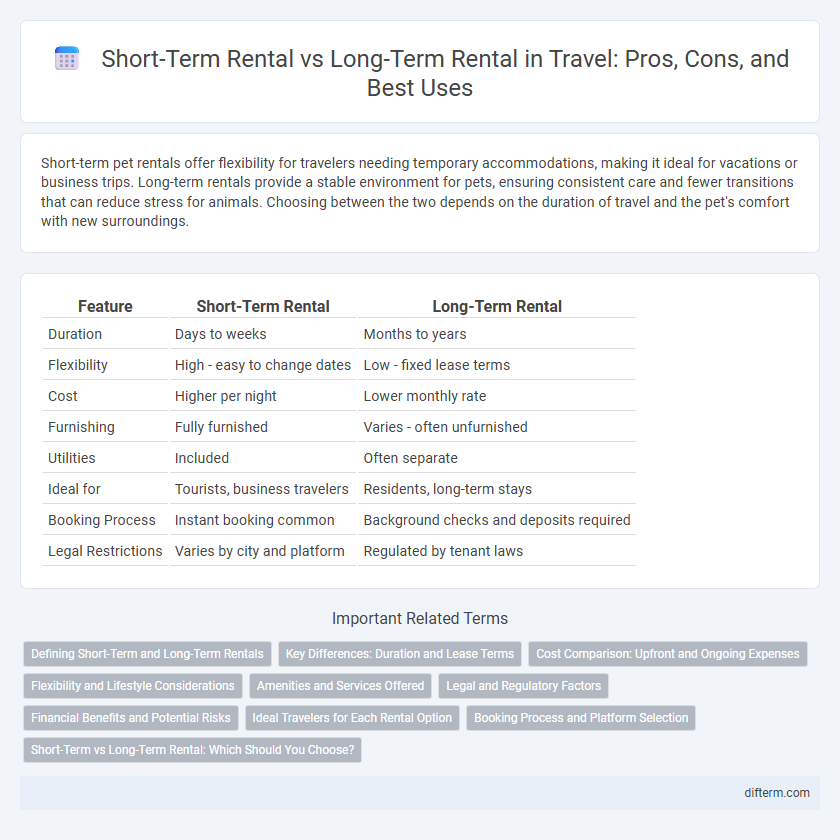Short-term pet rentals offer flexibility for travelers needing temporary accommodations, making it ideal for vacations or business trips. Long-term rentals provide a stable environment for pets, ensuring consistent care and fewer transitions that can reduce stress for animals. Choosing between the two depends on the duration of travel and the pet's comfort with new surroundings.
Table of Comparison
| Feature | Short-Term Rental | Long-Term Rental |
|---|---|---|
| Duration | Days to weeks | Months to years |
| Flexibility | High - easy to change dates | Low - fixed lease terms |
| Cost | Higher per night | Lower monthly rate |
| Furnishing | Fully furnished | Varies - often unfurnished |
| Utilities | Included | Often separate |
| Ideal for | Tourists, business travelers | Residents, long-term stays |
| Booking Process | Instant booking common | Background checks and deposits required |
| Legal Restrictions | Varies by city and platform | Regulated by tenant laws |
Defining Short-Term and Long-Term Rentals
Short-term rentals typically refer to accommodations leased for periods ranging from a single night up to 30 days, commonly found in vacation homes, Airbnb listings, and hotel alternatives. Long-term rentals are agreements lasting more than 30 days, often six months to a year or longer, providing stable housing for residents and tenants. Understanding the distinction helps travelers and property owners align expectations regarding lease terms, amenities, pricing, and legal regulations.
Key Differences: Duration and Lease Terms
Short-term rentals typically range from a few days to a few weeks, offering flexible lease terms ideal for travelers or temporary stays. Long-term rentals usually require leases of six months to a year or more, providing stability and consistent monthly payments. The duration and lease conditions significantly influence cost, amenities, and tenant obligations in each rental type.
Cost Comparison: Upfront and Ongoing Expenses
Short-term rentals usually demand higher upfront costs per stay, including security deposits, cleaning fees, and premium nightly rates, while long-term rentals offer lower monthly rent and reduced utility expenses spread over time. Ongoing expenses for short-term rentals often fluctuate with occupancy rates and seasonal demand, leading to variable income streams, whereas long-term rentals provide consistent monthly payments with predictable maintenance costs. Understanding the balance between initial investment and recurring costs is crucial for travelers and property investors when choosing between short-term and long-term rental options.
Flexibility and Lifestyle Considerations
Short-term rentals offer unparalleled flexibility for travelers seeking varied experiences, allowing stays from a few days to weeks without long commitments. Long-term rentals provide stability and cost-efficiency, catering to those prioritizing a consistent living environment and lifestyle integration. Choosing between them depends on balancing the desire for flexibility against the need for routine and financial predictability in travel plans.
Amenities and Services Offered
Short-term rentals often provide fully furnished spaces with essential amenities like Wi-Fi, kitchen appliances, and weekly housekeeping to cater to travelers' comfort and convenience. Long-term rentals typically include basic utilities and maintenance services but may lack frequent cleaning or additional hospitality features. Choosing between the two depends on the desired level of service and immediate accessibility to amenities during the stay.
Legal and Regulatory Factors
Short-term rentals often face stricter legal regulations and zoning laws compared to long-term rentals, with many cities imposing licensing requirements and occupancy limits to control tourism impact. Long-term rentals generally benefit from more established tenant protections and stable regulatory frameworks that govern lease agreements and eviction procedures. Understanding local ordinances and compliance obligations is crucial for both property owners and renters to avoid fines and legal disputes.
Financial Benefits and Potential Risks
Short-term rentals often generate higher monthly income due to premium nightly rates but incur increased costs such as cleaning, maintenance, and vacancy periods. Long-term rentals provide stable cash flow with reduced turnover expenses and consistent tenant occupancy, lowering financial uncertainty. Potential risks of short-term rentals include regulatory restrictions and market seasonality, while long-term rentals face tenant reliability and lease default risks impacting revenue stability.
Ideal Travelers for Each Rental Option
Short-term rentals appeal primarily to tourists, business travelers, and digital nomads seeking flexibility, comfort, and local experiences during brief stays ranging from a few days to a few weeks. Long-term rentals attract expatriates, remote workers, and relocating families who require stability, cost savings, and a permanent living arrangement for months or years. Understanding traveler needs and duration of stay optimizes accommodation choices in the competitive travel rental market.
Booking Process and Platform Selection
Short-term rentals typically require quick booking through platforms like Airbnb or Vrbo, offering instant confirmation and flexible check-in options, while long-term rentals often involve more extensive application processes on sites such as Zillow or Apartments.com, including background checks and lease agreements. Platform selection depends on rental duration, with Airbnb favoring short stays and Zillow specializing in long-term leases, impacting user interface, payment methods, and customer support features. Efficient booking for short-term rentals centers on speed and convenience, whereas long-term rentals prioritize thoroughness and security in tenant screening.
Short-Term vs Long-Term Rental: Which Should You Choose?
Short-term rentals offer flexibility and furnished accommodations ideal for travelers seeking temporary stays or vacation experiences, often providing amenities like Wi-Fi and housekeeping. Long-term rentals generally require lease agreements of six months or more, offering cost savings and stability for expatriates, remote workers, or residents planning to stay in one location. Choosing between the two depends on factors such as duration of stay, budget, lifestyle preferences, and purpose of travel.
short-term rental vs long-term rental Infographic

 difterm.com
difterm.com